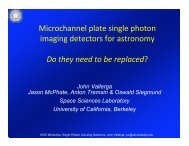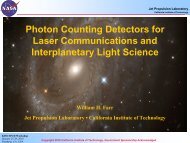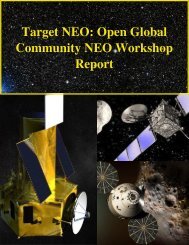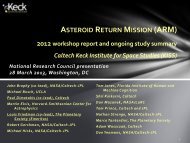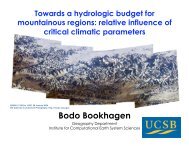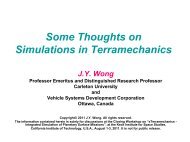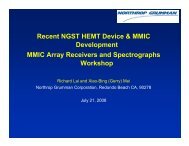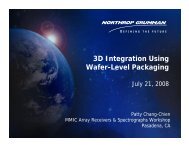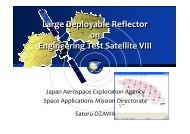Asteroid Retrieval Feasibility - Keck Institute for Space Studies ...
Asteroid Retrieval Feasibility - Keck Institute for Space Studies ...
Asteroid Retrieval Feasibility - Keck Institute for Space Studies ...
Create successful ePaper yourself
Turn your PDF publications into a flip-book with our unique Google optimized e-Paper software.
<strong>Asteroid</strong> <strong>Retrieval</strong> <strong>Feasibility</strong><br />
ESA ESTEC: March 14, 2012<br />
Louis Friedman & Marco Tantardini<br />
1
STUDY Co-Leads<br />
John Brophy (NASA JPL)<br />
Fred Culick (Caltech)<br />
Louis Friedman (The Planetary Society)<br />
• Carl Allen (NASA JSC)<br />
• David Baughman (Naval Postgraduate School)<br />
• Julie Bellerose (NASA ARC)<br />
• Bruce Betts (The Planetary Society)<br />
• Mike Brown (Caltech)<br />
• Michael Busch (UCLA)<br />
• John Casani (NASA JPL)<br />
• Marcello Coradini (ESA)<br />
• John Dankanich (NASA GRC)<br />
• Paul Dimotakis (Caltech)<br />
• Martin Elvis (Harvard-Smithsonian Center <strong>for</strong> Astrophysics)<br />
• Ian Garrick-Bethell (UCSC)<br />
• Robert Gershman (NASA JPL)<br />
• Tom Jones (Florida <strong>Institute</strong> <strong>for</strong> Human and Machine<br />
Cognition)<br />
• Damon Landau (NASA JPL)<br />
• Chris Lewicki (Arkyd Astronautics)<br />
2<br />
Two Workshops – Sept 2011, Feb 2012<br />
• John Lewis (University of Arizona)<br />
• Pedro Llanos (USC)<br />
• Mark Lupisella (NASA GSFC)<br />
• Dan Mazanek (NASA LaRC)<br />
• Prakhar Mehrotra (Caltech)<br />
• Joe Nuth (NASA GSFC)<br />
• Kevin Parkin (NASA ARC)<br />
• Rusty Schweickart (B612 Foundation)<br />
• Guru Singh (NASA JPL)<br />
• Nathan Strange (NASA JPL)<br />
• Marco Tantardini (The Planetary Society)<br />
• Brian Wilcox (NASA JPL)<br />
• Colin Williams (NASA JPL)<br />
• Willie Williams (NASA JSC)<br />
• Don Yeomans (NASA JPL)
3 Planetary Society Presentation to ESA<br />
• Near human mission target<br />
beyond the Moon<br />
• First step on flexible path into<br />
the solar system<br />
• Test bed <strong>for</strong> human exploration<br />
operations<br />
• <strong>Asteroid</strong> Exploration/ Resource<br />
Utilization<br />
• Water<br />
• Propellants<br />
• Materials <strong>for</strong> radiation shielding<br />
• Science
4 Planetary Society Presentation to ESA<br />
1. Objectives<br />
2. Target Identification<br />
3. Destinations and Investigations<br />
4. Flight System and Capture Mechanism<br />
5. Mission and Trajectory Design<br />
6. Mission Benefits<br />
7. COMPASS Study<br />
8. Conclusions<br />
9. Roadmap<br />
10. Follow-up
5 Planetary Society Presentation to ESA<br />
• Determine the feasibility of robotically capturing and<br />
returning a small near-Earth asteroid to the vicinity of<br />
the Earth using technology available in this decade.<br />
• Identify the benefits to NASA, the scientific community,<br />
the aerospace community, and the general public of<br />
such an endeavor.<br />
• Identify how this endeavor could impact NASA’s and<br />
the international space community’s plans <strong>for</strong> human<br />
exploration beyond low-Earth orbit.
6 Planetary Society Presentation to ESA<br />
Determine minimum asteroid size that enables a target discovery<br />
and characterization rate to provide candidate NEAs by 2020.<br />
• Larger asteroids easier to discover and characterize but much harder to move.<br />
• Volume and mass scale as the cube of the diameter,<br />
• projected area (and brightness) scales as the square of the diameter<br />
Determine the overlap between NEAs large enough to be discovered<br />
and characterized and those small enough to be moved<br />
For each candidate target asteroid need to know:<br />
• orbit<br />
• spectral type<br />
• size<br />
• shape<br />
• spin state<br />
• mass
Two Types of Targets<br />
A boulder from a known large asteroid Find a small asteroid (3-7 m)<br />
Part of an asteroid could be perceived as<br />
glorified sample return<br />
Difficult to predict, likely<br />
not carbonaceous, random<br />
select, but lots of potential<br />
targets<br />
Planetary Society Presentation to ESA<br />
7
Ideal Target: Carbonaceous<br />
Water/ice<br />
to make<br />
propellants<br />
Heating<br />
provides<br />
accessible<br />
platinum<br />
group<br />
metals<br />
Planetary Society Presentation to ESA<br />
8
9 Planetary Society Presentation to ESA<br />
<strong>Asteroid</strong> Mass vs Diameter<br />
The<br />
International<br />
<strong>Space</strong> Station<br />
has a mass of<br />
450,000 kg: as<br />
a 7-m diameter<br />
asteroid<br />
Diameter<br />
<strong>Asteroid</strong> Mass (kg)<br />
(m) 1.9 g/cm 3 2.8 g/cm 3 3.8 g/cm 3<br />
2.0 7,959 11,729 15,917<br />
2.5 15,544 22,907 31,089<br />
3.0 26,861 39,584 53,721<br />
3.5 42,654 62,858 85,307<br />
4.0 63,670 93,829 127,339<br />
4.5 90,655 133,596 181,309<br />
5.0 124,355 183,260 248,709<br />
5.5 165,516 243,918 331,032<br />
6.0 214,885 316,673 429,770<br />
6.5 273,207 402,621 546,415<br />
7.0 341,229 502,864 682,459<br />
7.5 419,697 618,501 839,394<br />
8.0 509,357 750,631 1,018,714<br />
8.5 610,955 900,354 1,221,909<br />
9.0 725,237 1,068,770 1,450,473<br />
9.5 852,949 1,256,977 1,705,898<br />
10.0 994,838 1,466,077 1,989,675<br />
The majority of NEAs have densities between 1.9 g/cm 3 and 3.8 g/cm 3 .
10 Planetary Society Presentation to ESA<br />
• ~20,500 NEAs >100 meters: about 25% discovered to date<br />
• Millions of NEAs >10 meters and billions of NEAs >2 meters<br />
• less than one percent have been discovered<br />
• Small NEAs discovered only during very close Earth approaches<br />
• however, 280 asteroids approximately 10-m diameter discovered<br />
• few of these currently have secure orbits<br />
Present Knowledge<br />
• none of them have the physical (spectral class, albedos, true diameters…)
11<br />
Planetary Society Presentation to ESA<br />
Entendu: product of the telescope’s aperture and its field of view.<br />
• <strong>for</strong> Catalina Sky Survey (CSS) entendu is ~ 2<br />
• <strong>for</strong> Panoramic Survey Telescope and Rapid Response System 1 (Pan<br />
STARRS 1) etendu expected to be ~ 13 when fully operational<br />
• <strong>for</strong> PanSTARRS 4, entendu will be ~ 51<br />
Increasing Our Knowledge<br />
• Large Synoptic Survey Telescope (LSST), entendu ~ 320 (planed 2018)<br />
The number of accessible<br />
targets today should increase<br />
by two orders of magnitude<br />
when the next generation NEO<br />
search telescopes come on line
12 Planetary Society Presentation to ESA<br />
• First knowledge is orbit and absolute magnitudes<br />
Target Mass<br />
• Albedo determines diameter from absolute magnitude<br />
• most NEAs albedos 0.05 - 0.20, yields diameter to a factor of 2<br />
• The object's volume can only be quantified to within a<br />
factor of 8 or 10<br />
• The mass of an NEA to within factor of 20 <strong>for</strong> objects<br />
without any in<strong>for</strong>mation beyond the discovery magnitude<br />
• Estimate asteroid’s mass accurately with additional data:<br />
• follow-up observations must occur as soon as possible after a<br />
potential target is discovered - ideal start within a day
13 Planetary Society Presentation to ESA<br />
Follow-Up Observations<br />
• Additional optical astrometry to better determine the NEA’s trajectory and<br />
ensure that it will not be lost (professional and amateur astronomers)<br />
• Optical lightcurve measurements <strong>for</strong> the object’s spin rate and if it is in a<br />
tumbling non-principal-axis rotation state or not<br />
• Optical and near-infrared spectroscopy <strong>for</strong> asteroid’s composition<br />
• High-sensitivity spectroscopy (optical and near-IR): will unambiguously<br />
indicate a carbonaceous chondrite composition
14 Planetary Society Presentation to ESA<br />
Additional Measurements Needed<br />
• Thermal infrared flux measurements <strong>for</strong> object’s<br />
albedo.<br />
•For small objects dimensions are only<br />
accurate to ~30-40%.<br />
• Radar ranging measurements to determine orbit<br />
and dimensions<br />
• Goldstone Radar can image asteroids with<br />
resolution 3.75 m.<br />
• With optical astrometry only, require at least two<br />
epochs of observation separated by several years to<br />
obtain a similar orbit solution.<br />
• With radar imaging, obtain a ~10-m NEA's<br />
dimensions to within
15 Planetary Society Presentation to ESA<br />
Actions to Increase Discovery Rate<br />
Goal: Locate several accessible ~10-m carbonaceous-chondrite objects which<br />
could be returned to Earth in the 2020’s.<br />
Increase is possible with minor adjustments in current programs:<br />
• A 10-m asteroid at ~0.03 AU have an apparent magnitude of 18 and be<br />
moving at ~1º/hour.<br />
• Both Pan-STARRS and Palomar Transient Factory (PTF) currently automatically<br />
reject such fast-moving objects<br />
• if the pipelines can be modified to report such detections instead these two<br />
surveys should discover roughly three 10-m objects per night<br />
• Follow-up observations must be executed in a matter of hours or days.
16 Planetary Society Presentation to ESA<br />
Target Identification: Conclusions<br />
• Small asteroids only discovered when they make very close<br />
approach to Earth<br />
• Synodic periods of approximately one decade <strong>for</strong> NEAs of<br />
interest:<br />
• enables object to be discovered and characterized followed by a mission<br />
targeted to return the NEA by the next close approach ~ 10 years later<br />
• One example: <strong>Asteroid</strong> 2008HU4 (proof of concept):<br />
• estimated to be roughly 7-m in diameter and will make its next close<br />
approach to Earth in 2016 with a subsequent close approach in 2026<br />
• Alternative approach is to target a larger NEA, knowing it likely<br />
a rubble pile to take a 7-m piece off it.<br />
• if a single right-sized piece cannot be found, then collect<br />
enough regolith or many small pieces
17 Planetary Society Presentation to ESA<br />
• What type of asteroid would be most desirable to bring back?<br />
• To what final destination should the asteroid be delivered?<br />
• What should the asteroid be used <strong>for</strong> at this location?<br />
Carbonaceous asteroids are the most compositionally diverse asteroids and<br />
contain a rich mixture of volatiles, dry rock, and metals.<br />
• Human mission architecture team has selected EM L2<br />
• Final destination of Lunar orbit or outer Earth-Moon Lagrange point<br />
(L2 is selected by safety and other mission design factors)<br />
• L2 is also a place at which there is some <strong>for</strong>eseeable future demand<br />
<strong>for</strong> water and water-derived propellants.
The Earth-Moon L2 Destination<br />
18<br />
Planetary Society Presentation to ESA<br />
18
19 Planetary Society Presentation to ESA<br />
SAFETY<br />
A key issue both in fact and in perception<br />
• <strong>Asteroid</strong> is meteorite sized, no more<br />
dangerous than objects that regularly impact<br />
• The carbonaceous asteroids such that it will<br />
break up harmlessly in the Earth’s atmosphere<br />
• <strong>Space</strong>craft control ability can move asteroid<br />
away from Earth<br />
• Target is stable lunar orbit: instability would<br />
lead it to the Moon, not Earth
20 Planetary Society Presentation to ESA<br />
15.0 m<br />
10.0 m<br />
Capture Bag<br />
Deployed<br />
Solar Array Wing<br />
36 deg<br />
10.7 m<br />
<strong>Space</strong>craft Bus<br />
Structure<br />
5.9 m<br />
5.8 m<br />
2.7 m<br />
35.7 m<br />
Hall Thrusters
21 Planetary Society Presentation to ESA<br />
• 40 kW (end of life at 1 AU) SEP<br />
• two solar panels each of 71 m 2<br />
• 150 W/kg available <strong>for</strong> a launch in 2020<br />
• Five 10-kW Hall thrusters<br />
• 19 kg/thruster<br />
• specific impulse up to 3000s at thruster input power level of ~10 kW<br />
• Seven xenon tanks needed to store the 11,430 kg of xenon<br />
required <strong>for</strong> this mission - each tank would have a diameter of 650<br />
mm and is 3,500 mm long<br />
• Two flight system architectures considered:<br />
• Separable <strong>Space</strong>craft Architecture<br />
• Single <strong>Space</strong>craft Architecture
22 Planetary Society Presentation to ESA<br />
Single or Dual <strong>Space</strong>craft Options<br />
Separable <strong>Space</strong>craft - SEP Stage (SS) and NEA capture S/C<br />
-SS provides<br />
• Interplanetary propulsion (outbound and inbound)<br />
• Long-range communications with Earth<br />
• Short-range communications with the S/C<br />
• Post-capture rendezvous with S/C<br />
- Capture S/C provides<br />
• Capture and de-tumbling of NEA<br />
• Instruments <strong>for</strong> in-situ characterization of NEA<br />
• cameras to assist in capture<br />
Single <strong>Space</strong>craft<br />
- Characterization and capture functionality included in SEP<br />
vehicle<br />
- Studied by GRC’s COMPASS team<br />
- Launch Mass = 17,000 kg (12,000 kg Xenon +<br />
900 kg hydrazine)
23 Planetary Society Presentation to ESA<br />
Pros and Cons of Separable S/C<br />
- Pros<br />
- Cons<br />
• Allows smaller, more nimble capture vehicle<br />
• SEP Stage provide comm relay and remote observation of NEA capture<br />
• Costs assumed to be higher (two vehicles)<br />
• AR&D with SEP Stage required<br />
• Limited energy capability on capture S/C
24 Planetary Society Presentation to ESA<br />
• Using SEP to stop a spinning NEA<br />
is simple if it can be grappled<br />
effectively<br />
• A 30 kW SEP system can stop a<br />
NEA w/ 2-m radius & 10-minute spin<br />
period in 1 revolution<br />
• The bag accommodates 1000<br />
cubic meters of sample and must<br />
be deployed<br />
• Inflated tube open the bag tubes<br />
and the whole assembly is made of<br />
fabric and deploys out of a<br />
compact package<br />
Capturing and De-Spinning a NEA
25 Planetary Society Presentation to ESA<br />
Launch Configuration<br />
Outbound Transit<br />
Configuration<br />
<strong>Asteroid</strong> Capture<br />
Bag Deployed<br />
<strong>Asteroid</strong> Capture<br />
Configuration<br />
Inbound Transit<br />
Configuration
26 Planetary Society Presentation to ESA<br />
Candidate Instruments<br />
N/A<br />
Parameters<br />
Format/<br />
Heritage<br />
Vis Cam<br />
(OpNav)<br />
Dawn Camera<br />
Vis Cam<br />
(ProxOps)<br />
Ecliptic<br />
NIR Spec LIDAR CubeSat probes; pod<br />
Pushbom<br />
M3<br />
3D flash<br />
STORRM<br />
3-4 x 1 U; 1-2 x 2 U?<br />
3-axis accels; comm;<br />
explosive pod? (BATC)<br />
FOV (deg) 5.5 x 5.5 10 x 10 25 x 1 < 200 mrad ~5 x 5<br />
IFOV 94 µrad 200 µrad 1 mrad 0.2 mrad 100 µrad<br />
Range<br />
0.36-1.05 µm;<br />
7+1 channels<br />
0.45-0.9 µm 0.4-3 µm<br />
1µm<br />
< 30 km<br />
RGB<br />
Resolution
27 Planetary Society Presentation to ESA<br />
Overall mission design assumed launched to LEO on Atlas V 551-class vehicle:<br />
• SEP system spirals<br />
to HEO) in 2.2 years<br />
• Lunar gravity assist<br />
(LGA) provides C3 >0<br />
• SEP system<br />
heliocentric transfer<br />
to NEA in 1.7 years<br />
• 90 days assumed at<br />
target<br />
• Captured NEA to<br />
cis-lunar space into<br />
stable high lunar<br />
orbit in 2-6 years<br />
<strong>Asteroid</strong> Orbit<br />
Moon’s Orbit<br />
2. Separation &<br />
S/A Deployment<br />
5. Cruise to <strong>Asteroid</strong><br />
(1.7 years) 7. Return to<br />
Lunar Orbit<br />
(2 to 6 years)<br />
4. Lunar Gravity Assist<br />
1. Launch<br />
Atlas V 551<br />
3. Spiral Out<br />
to Moon (2.2 years)<br />
6. <strong>Asteroid</strong> Operations<br />
(90 days: Deploy bag, capture<br />
and de-tumble asteroid)<br />
8. Lunar Gravity Assist<br />
9. Transfer to<br />
high Lunar orbit<br />
407 km LEO Circular Orbit<br />
Earth
28 Planetary Society Presentation to ESA<br />
SEP System: Per<strong>for</strong>mance<br />
Specific Impulse (s)<br />
Efficiency<br />
3500<br />
3000<br />
2500<br />
2000<br />
1500<br />
1000<br />
500<br />
0<br />
0.0 5.0 2.5 10.0 5.0 15.0 7.5 20.0 10.0 12.5 25.0<br />
0.0 5.0 2.5 10.0 5.0 15.0 7.5 10.0 20.0 12.5 25.0<br />
0.800<br />
35.00<br />
System Input Power (kW)<br />
0.700<br />
30.00<br />
System Input Power (kW)<br />
0.600<br />
25.00<br />
0.500<br />
0.400<br />
20.00<br />
0.300<br />
15.00<br />
0.200<br />
10.00<br />
0.100<br />
0.000<br />
0.0 5.0 2.5 10.0 5.0 15.0 7.5 10.0 20.0 12.5 25.0<br />
0.0 5.0 2.5 10.0 5.0 15.0 7.5 20.0 10.0 12.5 25.0<br />
System PPU Input Power (kW)<br />
Thrust (mN)<br />
Mass Flow Rate (mg/s)<br />
1000.0<br />
900.0<br />
800.0<br />
700.0<br />
600.0<br />
500.0<br />
400.0<br />
300.0<br />
200.0<br />
100.0<br />
0.0<br />
5.00<br />
0.00<br />
PPU System Input Input Power (kW)
29 Planetary Society Presentation to ESA<br />
Spiral Out<br />
Trajectory be<strong>for</strong>e escape<br />
simulated with SNAP<br />
(shadowing included)<br />
Duration = 890 days<br />
Total ΔV = 6645m/s<br />
Start mass = 18,800kg<br />
Final mass after LGA =<br />
14,995kg<br />
Propellant prior to LGA =<br />
3,805kg
30 Planetary Society Presentation to ESA<br />
SEP Power<br />
Parameter Value Comments<br />
Specific Impulse, Isp<br />
40 kW<br />
3000 s<br />
EP System Efficiency 60%<br />
<strong>Space</strong>craft Dry Mass<br />
Atlas V 521-class LV<br />
Launch Mass to LEO<br />
5.5 t<br />
13.5 t<br />
Spiral Time 1.6 years No shadowing<br />
Spiral Xe Used<br />
Mass at Earth Escape<br />
Atlas V 551-class LV<br />
Launch Mass to LEO<br />
Spiral Time<br />
Spiral Xe Used<br />
Mass at Earth Escape<br />
2.8 t<br />
10.7 t<br />
18.8 t<br />
2.2 years<br />
3.8 t<br />
15.0 t<br />
Spiral ∆V 6.6 km/s LEO-intersect Moon<br />
Escape/Capture C3 2 km 2 /s 2 Lunar assisted<br />
NEA Stay Time<br />
90 days<br />
Proof of Concept Mission -1-<br />
• Example mission capturing<br />
entire small NEA (~7 m)<br />
• 1300 t returned<br />
• 2008 HU4 has a radar<br />
opportunity in 2016<br />
2008 HU4
31 Planetary Society Presentation to ESA<br />
Proof of Concept Mission -2-<br />
1998 KY26<br />
Designation<br />
Returned<br />
Mass, t<br />
Xe, t (no<br />
Spiral)<br />
Earth<br />
Escape<br />
Flight<br />
Time, yr<br />
(no<br />
spiral)<br />
Arrival<br />
C3,<br />
km 2 /s 2<br />
2008 HU4 250 5.0 4/27/2022 4.0 1.8<br />
2008 HU4 400 5.2 4/27/2021 5.0 1.7<br />
2008 HU4 650 6.5 4/27/2020 6.0 1.6<br />
2008 HU4 950 8.9 a 4/28/2019 7.0 1.6<br />
2008 HU4 1300 9.1 a 4/28/2018 8.0 1.6<br />
• Example mission returning<br />
part of a well-characterized<br />
30-m carbonaceous NEA<br />
• 60 t returned<br />
2008 HU4 200 8.7 a 8/15/2017 8.0 0.0 b<br />
1998 KY26 30 4.9 11/11/2019 4.7 2.0<br />
1998 KY26 60 4.2 7/19/2020 5.3 2.0<br />
2000 SG344 1800 1.8 3/8/2027 2.6 2.0<br />
2000 SG344 3600 1.5 2/14/2027 2.6 2.1<br />
2000 SG344 100 6.3 4/20/2024 6.5 0.0 b<br />
a<br />
Requires Atlas V (551)-class launch vehicle. All others<br />
assume an Atlas V (521)-class launch.<br />
b<br />
Capture directly to Sun-Earth L2 via a stable manifold. All<br />
others assume lunar capture to S-E L2.
32 Planetary Society Presentation to ESA<br />
Trajectory from Escape to Arrival<br />
After ~4.5 months from the LGA, the asteroid can be<br />
captured into a stable high lunar orbit with 0.0 m/s Δv
33 Planetary Society Presentation to ESA<br />
MISSION BENEFITS<br />
• Synergy with near-term human exploration<br />
• provides EM L2 target and operations goal<br />
• Process development <strong>for</strong> the exploitation of asteroid<br />
resources<br />
• crucial <strong>for</strong> long-duration space flight<br />
• Synergy with planetary defense<br />
• demonstrates control and adds to international<br />
framework<br />
• Expansion of international cooperation in space<br />
• advances and broadens human space flight<br />
• Commercial and private interest<br />
• stimulating new participation
34 Planetary Society Presentation to ESA<br />
• First goal beyond the Moon<br />
• Step to interplanetary space and more<br />
distant NEAs with longer flights<br />
• Further steps to Phobos, Deimos<br />
• Surface and near by operations prepares<br />
humans <strong>for</strong> future ventures, even to Moon<br />
and Mars<br />
• significant science<br />
• future utilization of in-space<br />
resources<br />
Synergy with Near-term<br />
Human Exploration
35 Planetary Society Presentation to ESA<br />
Exploitation of <strong>Asteroid</strong> Resources<br />
• Extraction and purification of water<br />
• Electrolysis of water into hydrogen and oxygen<br />
and their liquefaction<br />
• ”Baking” to <strong>for</strong>ce autoreduction of the major<br />
mineral magnetite (Fe 3 O 4 ) by the carbonaceous<br />
polymer, leading to total release of H2O, CO,<br />
CO2, N<br />
• Using released CO as a reagent <strong>for</strong> extraction,<br />
separation, purification, and fabrication of iron<br />
and nickel products.
36 Planetary Society Presentation to ESA<br />
Synergy with Planetary Defense<br />
• Moving the asteroid<br />
• Safe planetary defense test<br />
• Test technology<br />
• Greater attention to the planetary<br />
defense challenge<br />
Techniques <strong>for</strong> proximity<br />
operations and NEO navigation<br />
gained from returning an<br />
asteroid would be directly<br />
transferable planetary defense<br />
planning and implementation.
37 Planetary Society Presentation to ESA<br />
Expansion of International Cooperation<br />
in <strong>Space</strong><br />
• Human exploration architecture will be international<br />
• Samples could be returned to Earth <strong>for</strong> study<br />
• <strong>Space</strong>-faring nations would have access to the body<br />
• Establish legal and political protocols <strong>for</strong> altering<br />
celestial objects
38 Planetary Society Presentation to ESA<br />
Commercial and Private Interest<br />
• Determination of in-site resource utilization<br />
• Creation of prizes <strong>for</strong> technical steps
39 Planetary Society Presentation to ESA<br />
System and Mission Point Design<br />
NASA Glenn Research Center
40 Planetary Society Presentation to ESA<br />
FY12$M<br />
NASA insight/oversight 204 15% of prime contractor costs<br />
Phase A 68 5% of B/C/D costs<br />
<strong>Space</strong>craft 1359<br />
Prime Contractor B/C/D cost plus fee<br />
(10% - less science payload)<br />
Launch Vehicle 288 Atlas 551<br />
Mission Ops/GDS 117 10 year mission plus set-up<br />
Reserves 611 30% reserves<br />
Total 2647
• Feasible and safe to capture and move entire NEA to cis-lunar space<br />
• Companion NASA study (COMPASS) estimated cost ~$2.6 billion<br />
• Many benefits identified<br />
• Human first step target beyond the Moon is the rationale<br />
• This is the only way that humans can actually reach an asteroid<br />
by mid-2020s satisfying the Presidential goal<br />
• Discovery and characterization campaign <strong>for</strong> small NEAs is needed<br />
• C-type, >7 meters with a synodic period of ~ 10 years desired<br />
• boulder from large known NEA eases observation requirements<br />
• Practical 40 kw SEP system identified<br />
• Safe orbit transfer trajectories identified<br />
• Several capture mechanisms proposed<br />
• “bag” appears most promising<br />
• possible design competition <strong>for</strong> students<br />
• Additional work needed (see follow up)<br />
41 Planetary Society Presentation to ESA
42 Planetary Society Presentation to ESA<br />
Beyond the Moon: Stepping<br />
into the Solar System<br />
Benefits at Interim Milestone<br />
-- Possible Relation to ESA<br />
NEO observation campaign<br />
Ground and space based<br />
Move selected NEO to EM L2<br />
Human mission to L2<br />
Robotic precursor to selected NEO<br />
Human mission(s) to NEO(s)<br />
Human missions to Phobos or Deimos<br />
Humans to Mars<br />
Science and planetary defense<br />
Exciting robotic adventure<br />
Tech. demo <strong>for</strong> planetary defense<br />
New astronaut distance record<br />
Advance human flight capability<br />
Prepares the next step to NEO<br />
Unique experiment testing ISRU<br />
Characterization of human target<br />
New distance, duration records<br />
Advance human flight capability<br />
Prepares long duration flight<br />
Advances space industry, utility<br />
Apollo 8 analogy <strong>for</strong> Mars<br />
Teleoperated exploration of Mars<br />
Prepares next step to Mars
• Follow-up proposals to KISS and NASA<br />
• exposure to NASA human program required<br />
• NEO Observation campaign<br />
• Capture technology<br />
• Resource Extraction Demonstration<br />
• Mission/system design – incl. trajectories<br />
Program development: international and private possibilities;<br />
roadmap -- Discuss cooperation opportunities with ESA<br />
• Student completion: Capture schemes<br />
• IAC presentation (1-5 October, Naples)<br />
• other conference presentations and papers<br />
43 Planetary Society Presentation to ESA




